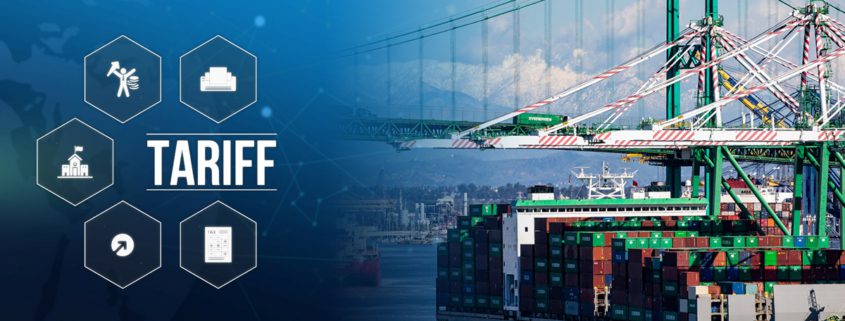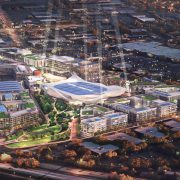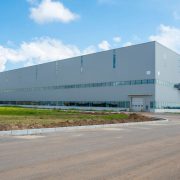Tariff Policy Creating Uncertainty in SoCal Industrial Markets
Following President Trump’s election, there were multiple reasons to be optimistic that the industrial sector would rebound under the new administration. Expectations of pro-growth policies (including potential deregulation and tax cuts) and a continued increase in e-commerce (which grew 8.0% in 2024) would spur warehouse/distribution leasing, and the decrease in new construction starts would balance the supply and demand equation.
Then came President Trump’s Liberation Day tariff announcements, which upended existing trade policy and created extreme volatility in the markets. While the long-term effects of the tariffs on the industrial sector appear contingent on how the policies would evolve over time, the uncertainty affects the decision-making process of businesses and investors. “Are all of these tariffs going to go into place? Will some be negotiated down? How long will they last?” Jesse Gundersheim, a senior director of market analytics who covers Orange County and the Inland Empire for CoStar, asked in an early April interview with the Los Angeles Times. “The unknown around it is not good for business. It’s not good for decision making.”
The Trump administration has recently made some concessions, but some damage has already been done. For instance, Prologis suspended $1 billion in development projects. Bisnow reports that the company also experienced a leasing slowdown in the first quarter that stemmed from tenants’ hesitation to make decisions amid economic uncertainty. In addition, CNBC reports that there has been an increase in canceled sailings by freight ships out of China in response to the trade wars, which will directly impact the Los Angeles and Inland Empire industrial markets. According to The Wall Street Journal, Gene Seroka, Executive Director of the Port of Los Angeles — the nation’s busiest port — warned last week of an imminent 35% drop in import volumes within two weeks.
As Patrick Connors, SVP/Partner of Voit’s San Diego office, writes in his Q1 Industrial Market assessment (available here), “The sooner the trade war reaches a finite conclusion, the better for everybody. Hopefully, that conclusion isn’t a drastic change one way or the other, as market stability will allow every business to confidently make sound, long-term decisions about the direction of their company.”
Even before the tariffs took effect, the national vacancy rate had increased to 7.1%, and SoCal has seen increases in vacancy in most markets. There were some bright spots, however. An in-depth assessment of each of the Southern California industrial markets, prepared by the Voit research team, can be found here, but let’s look at snapshots of the individual markets.
Orange County
Despite the uncertainty created by the fluctuating tariff policy, associate Ryan Osterkamp, Associate of the Irvine office has great faith in the resiliency of the Orange County industrial market. “It is undeniable that the tariffs will continue to impact consumers and businesses alike as long as they continue,” he writes. “While everyone waits for another shoe to drop, one thing is for certain. Orange County industrial real estate will remain a stable, high-demand market.”
Orange County’s industrial vacancy rate (5.37%) and availability rate (7.87%) rose slightly from Q4 2024. Year over year, the vacancy rate is up by more than 66%, and availability is up 51%, but the pace of increase appears to be easing, as savvy landlords are getting more aggressive with concessions to get their spaces leased up. Asking lease rates ($1.57) and sales pricing ($377.81) decreased slightly (approximately 8%) year-over-year, but both remain the highest in the country.
The Orange County Industrial Market has continued to be one of the least volatile markets in the nation, notwithstanding the economic turmoil.
San Diego
Like Osterkamp, San Diego SVP Connors remains optimistic despite the tariffs. “Not knowing which way the dominoes will fall has stagnated some market activity for now,” he says. “Deals are still getting done, however, and market sentiment remains positive overall with most owners and investors agreeing that 2025 will be a rebound from 2024.”
The vacancy rate (6.88%) and availability rate (89.7%) are up 28% and 18%, respectively, but landlords have taken a more aggressive approach in pursuing tenants, contributing to the bump in leasing activity in Q1. Two million square feet of total leasing in Q1 was the largest in a quarter for two years, the second largest quarterly total since Q2 2021, with Otay Mesa dominating the market for large lease transactions. In contrast to the bump in leasing activity, sales volume sank to a two-year quarterly low in both dollar and square-foot volume. The lack of demand for industrial property sales has started to pull sales prices lower. The median price per square foot in Q1 was $271.35.
One element factoring into the vacancy rate is the level of new construction. San Diego has added nearly 12 million square feet of industrial space since 2020 (most of which is in Otay Mesa), with another 1.4 million square feet under construction at the end of Q1 2025.
Los Angeles/Mid Counties
Los Angeles was one of the few markets that saw positive absorption, following eleven consecutive quarters of negative absorption. Some of the leasing velocity was driven by the increased activity at the Los Angeles, Long Beach, and San Pedro ports, which may experience a slowdown if trade relations with China are not normalized. “Tariffs are likely one of the main drivers in this surge in port activity, as businesses accelerated imports to stockpile goods ahead of expected policy changes,” reports Jordan Haynes, Associate of the Anaheim office. “For now, Los Angeles remains a vital hub for global trade, and the industrial market’s adaptation in the coming months will be crucial in determining its path forward in 2025.”
Los Angeles’s vacancy (5.51%) and availability (7.96%) rates remain well below the national average despite double-digit (13% and 17%) increases year over year. The average asking lease rate rose slightly in Q1, ending at $1.51 per square foot, up from $1.49 in Q4. This is still well below the $1.70 posted in Q1 last year. Core leasing demand is holding firm, especially for modern, functional space in infill locations. Sales volume is down slightly from Q4 2024, with 68 properties changing hands, totaling 2,290,946 square feet. Construction remains robust, with 4,303,839 SF of new space delivered over the past four quarters and approximately 1,837,980 SF of space under construction in Los Angeles County – although down significantly from the recent peak of more than 7,167,111 SF in mid-2023.
Inland Empire
John Viscounty, Vice President of the Ontario office, reports that in the Inland Empire, “signals are mixed. While some areas show promise, others face challenges… Lease rates are declining, but the pace of decline is slower than last year.”
The vacancy rate (7.14%) declined, and the availability rate (11.80%) rose slightly, but both remained virtually unchanged year over year. Landlords are still leaning on concessions to fuel activity, and rental rates remain stifled by competition from the recently delivered product and a mountain of sublease availability. Average asking leasing rates are down by 25% year over year. Construction levels have been falling as planned projects were delayed, and the existing pipeline of projects underway was completed and added to inventory. There were only 1.2 MSF of deliveries in Q1, the lowest quarterly total in years.
The encouraging start to the year will have some wind taken out of its sails at the beginning of Q2 as the overall direction of trade policy will be a point of consternation following the Liberation Day tariffs. A significant portion of the Inland Empire’s economy is driven by storing and distributing goods from China.
Visit the Voit Market Reports page for a more in-depth look at the individual markets. Talk with one of Voit Real Estate Services’ trusted commercial real estate advisors to learn more about how Voit can assist you with your commercial real estate needs.









